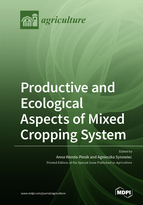Productive and Ecological Aspects of Mixed Cropping System
A special issue of Agriculture (ISSN 2077-0472). This special issue belongs to the section "Agricultural Systems and Management".
Deadline for manuscript submissions: closed (30 September 2020) | Viewed by 34136
Special Issue Editors
Interests: agricultural plant science; integrated cropping; weed management; experimental methods in agronomy
Special Issues, Collections and Topics in MDPI journals
Interests: allelopathy; weed biology and ecology; weed resistance to herbicides
Special Issues, Collections and Topics in MDPI journals
Special Issue Information
Dear Colleagues,
Mixed cropping, also known as inter-cropping or co-cultivation, is a type of plant production system that involves planting two or more species (or cultivars) simultaneously in the same field in a variable order—row or rowless. Mixed cropping plays an important role in sustainable agriculture by adding value to crop-rotations and agroecosystems. Complimentary use of environmental resources is provided by various species in a mixture in contrast to pure stands. Mixtures of cereals give higher yields of proteins, rich in essential amino acids, e.g., lysine. Mixtures of cereals and legumes provide valuable feed for livestock and play an essential role in promoting the biological activity of soils, especially by N fixation. They support the diversity of species in an agroecosystem, such as beneficial insects and diversity of weeds that may occur in a higher number of species, but below the economic thresholds. Still, the use of crop mixtures is not popular among farmers, particularly in a high input system. The key information on the economic costs of cultivation of mixed cropping is still missing. Scientific investigations on environmentally friendly mixed cropping should be supported by studies on the direct costs and long-term benefits that are most relevant to farmers.
Meeting the need to strengthen the scientific basis for mixed crops, we are ready to accept papers that enhance our understanding of the following:
- Selection of species and cultivars for a mixed crop and also a choice of agricultural treatments that will secure a stable yield of mixtures
- Inter- and intra- species competition of plants in a canopy
- Ecological intensification approach and opportunities for maximizing crop performance and yield in the mixtures
- Effects of mixed crops on crop-rotations
- Short- and long-term ecosystem benefits of mixtures
- Effects on pests and biodiversity of agroecosystems provided by mixtures
- Economic aspects of adopting the mixtures in farms
- The nutritive value of mixtures for livestock
- Other topics related to the mixed cropping
Prof. Dr. Anna Wenda-Piesik
Dr. Agnieszka Synowiec
Guest Editors
Manuscript Submission Information
Manuscripts should be submitted online at www.mdpi.com by registering and logging in to this website. Once you are registered, click here to go to the submission form. Manuscripts can be submitted until the deadline. All submissions that pass pre-check are peer-reviewed. Accepted papers will be published continuously in the journal (as soon as accepted) and will be listed together on the special issue website. Research articles, review articles as well as short communications are invited. For planned papers, a title and short abstract (about 100 words) can be sent to the Editorial Office for announcement on this website.
Submitted manuscripts should not have been published previously, nor be under consideration for publication elsewhere (except conference proceedings papers). All manuscripts are thoroughly refereed through a single-blind peer-review process. A guide for authors and other relevant information for submission of manuscripts is available on the Instructions for Authors page. Agriculture is an international peer-reviewed open access monthly journal published by MDPI.
Please visit the Instructions for Authors page before submitting a manuscript. The Article Processing Charge (APC) for publication in this open access journal is 2600 CHF (Swiss Francs). Submitted papers should be well formatted and use good English. Authors may use MDPI's English editing service prior to publication or during author revisions.
Keywords
- Sustainable agriculture
- stability of yielding
- quality of raw material
- ecological intensification
- ecosystem services
- economic aspects of mixed cropping







